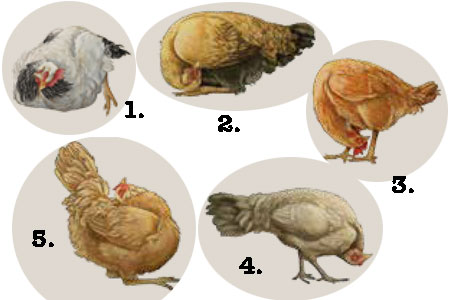
Wry neck is a neurological condition in which a chicken’s head turns to one side or to some other abnormal position. Also called crookneck, the technical word is torticollis, from the Latin words torquere, meaning “to twist,” and collum, meaning “neck.” Wry neck in chickens takes on different forms, including these (illustrated) five:
- Head tilted sideways
- Neck curved sideways
- Head tucked between the legs
- Neck twisted 180 degrees, head upside down
- Neck and head stretched over the back
Head or Neck Injury
Wry neck may result from a blow to the head or neck. Head injuries are fairly common in crested breeds, which tend to have skulls that are less bony than non-crested breeds. If the crested skull bone doesn’t entirely enclose the brain — because of either genetics or injury — a blow can cause the brain to swell and press through the skull’s gap.
A chicken with a head injury may tuck its head down between its legs (illustration No. 3) and perhaps move backward until the bird backs into an obstacle, such as a feeder or the brooder wall. Depending on the extent of the injury, the condition may be temporary or permanent.
Nutritional Deficiency
Wry neck in chicks may be caused, though rarely, by a deficiency of vitamin E or vitamin B1 (thiamin). The starter ration may be old and stale or improperly formulated. Or it may contain vitamin-destroying mycotoxins (poisons generated by mold). Excessive use of the coccidiostat amprolium can have the same effect.
Changing to fresh, quality feed and providing a vitamin supplement usually solves this problem. If it doesn’t, then most likely vitamin deficiency is not the cause of wry neck.
Hens that are manganese deficient lay poorly and produce thin-shell eggs with low hatchability. Chicks that do hatch from such eggs may, among other conditions, exhibit wry neck in the form of either head down between the legs (illustration No. 3) or stargazing (illustration No. 5).
Stargazing
Stargazing is a form of wry neck in which the head and neck pull over the bird’s back so the beak points toward the sky. The term is unfortunately used to refer to conditions with differing causes and outcomes.
Wry neck associated with painful muscle spasms is commonly called stargazing, but technically is opisthotonos, a Greek word meaning “drawn backward.” It differs from other forms of stargazing in occurring in spasms, rather than as a steady pull.
Congenital loco, which appears at the time of hatch, is one such nervous condition. The epileptic-like muscle spasms that pull the head back typically cause the bird to tip over. After a few days of flopping around, the chick dies from lack of food and water.
Commercial hatcheries discard affected chicks as they are removed from the hatcher. Because such chicks are rarely retained for study, no one is certain how common this condition is or exactly what causes it. The fact that it occurs only occasionally, and at the time of hatch, indicates that it may be a recessive genetic trait. A few studies have revealed the possibility of a defect in the ear structure.
A similar-appearing condition, also called stargazing, occurs several days after hatch. It is sporadic, lasts a few days, then disappears as mysteriously as it came. Although the condition looks identical to congenital loco, the fact that it occurs in older chicks and not at the time of hatch, and is not lethal, indicates that it is likely a separate condition with a different, but equally unknown, cause.
Bacterial or Viral Disease
Wry neck can be a manifestation of Marek’s disease, or may result from improperly administered Marek’s vaccine. A few less common viral and bacterial diseases also may cause wry neck, especially those that infect the inner ear. The result is loss of coordination and twisting of the neck, in a posture similar to stargazing.
And that’s today’s news from the Cackle Coop.
Gail Damerow is author of The Chicken Health Handbook, source of the above illustrations.

